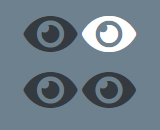Thank you for your participation!
Your Score is: / 50
Correct List of Differential Diagnoses: / 30
Correct Order of Differential Diagnoses: / 20
Our Differential:
Your Differential:
Our Diagnosis:
Primary Determinant:
Exam Results
Other History:
Patient had cataract surgery in the right eye 6 years ago and right after surgery it was discovered that the wrong power intraocular lens was implanted so it was replaced the next day. The right eye has just never felt right since then. The episodes of white out of vision started about 6 months ago. The left eye also had cataract surgery 5 years ago and the surgery went without any problems.
Exam Results
Normal vision of 20/20, no relative afferent pupil defect. Ocular motility normal. Intraocular pressure 13 mmHg OU. Dilated fundus exam showed normal retina, macula and optic nerves
The patient’s friend took a picture of her right eye during one of the episodes and this is what was seen:

Further exam
The patient was then asked to come to the clinic later that week after the episode cleared and the slit lamp exam showed the following:

This photo shows that the haptic of the intraocular lens is rubbing against the back surface of the iris causing a pattern of transillumination defect that corresponded to where the haptic was rubbing off the pigment and causing intermittent bleeding from an iris vessel into the anterior chamber during an episode.
Ultrasound imaging demonstrating the following:
 Displacement (tilting) of the intraocular lens causing the haptic to rub against the iris.
Displacement (tilting) of the intraocular lens causing the haptic to rub against the iris.
Further exam: when pressing on her globe, the retinal artery collapsed in the right eye with very little digital pressure on the eye, and the left eye’s central retinal artery did not collapse until moderate digital pressure was given
Preparation Planning : Case Review #31921376
Malmö, Sweden
October 2023
Assignment Instructions
Purpose
The purpose of this assignment is to work through one case at a time of a patient presenting with Transient Visual Loss. The differential diagnosis you provide will be graded and the score reported anonymously to the instructor. The goal of this exercise is to enhance classroom discussion and your answers may be presented in the class as talking points.
How to Complete the Assignment
The assignment requires you to investigate the patient history and additional patient results to determine a differential diagnosis. The elements of the history can be requested in any order you think is appropriate. You will be required to select each element of the history you think is most relevant to the patient’s chief complaint in a step-by-step manner, then you will be given the patient history for your inquiry, and then you will then reorder the Ranked Diagnosis elimating possbilities by clicking the trash can You will then repeat the process to determine other parts of the history that you think are the most relevant, until you are ready to submit your refined differential diagnosis of probable entities, ranked in order of their likelihood. You may enter your differential diagnosis at any time by clicking the "Differential Diagnosis" button. Once the diagnosis is submitted the assignment is complete and no further action is required until attending the lecture, where each case will be discussed as a group interaction.
Scoring
- The Student begins with a maximum 50 points
- 30 points are awarded for having all CORRECT Diagnoses present in your Differential
- Points will be deducted for selecting an incorrect diagnosis
- 20 points are awarded for having all Diagnoses in the CORRECT order of most to least likely
- Points are awarded for having each Diagnosis the CORRECT order
After the Lecture
You will be provided with a link to review the suggested way to work through the case along with keys points for evaluating each piece of the information from the patient history.
Case Review #31921376
Patient Presentation
64-year-old women who has been experiencing episodes of haziness in vision.
Click on the Cards Below to Learn More
Bilateral vs Unilateral

Bilateral vs Unilateral
Unilateral
Duration

Duration
Episodes can last a little as one hour when the vision is only mildly affected to as long as all day long for the episodes when vision is affected more severely.
Activity during the episode

Activity during the episode
Symptoms can last throughout the day regardless of activity.
Pattern of visual loss

Pattern of visual loss
Complete white out of vision in right eye", textAnswer:"Did not request information
Other Symptoms

Other Symptoms
There is no pain and no other symptoms
Current Medication

Current Medication
She saw a neurologist who put her on daily aspirin and since then the episodes have lasted longer.
How to "Score" Point
- The Student begins with a maximum 50 points
- 30 points are awarded for having all CORRECT Diagnoses present in your Differential
- Points will be deducted for selecting an incorrect diagnosis
- 20 points are awarded for having all Diagnoses in the CORRECT order of most to least likely
- Points are awarded for having each Diagnosis the CORRECT order
Patient Presentation
64-year-old women who has been experiencing episodes of haziness in vision.
Click on the Cards Below to Learn More
Bilateral vs Unilateral

Bilateral vs Unilateral
Unilateral
Duration

Duration
Episodes can last a little as one hour when the vision is only mildly affected to as long as all day long for the episodes when vision is affected more severely.
Activity during the episode

Activity during the episode
Symptoms can last throughout the day regardless of activity.
Pattern of visual loss

Pattern of visual loss
Complete white out of vision in right eye", textAnswer:"Did not request information
Other Symptoms

Other Symptoms
There is no pain and no other symptoms
Current Medication

Current Medication
She saw a neurologist who put her on daily aspirin and since then the episodes have lasted longer.
How to "Score" Point
- The Student begins with a maximum 50 points
- 30 points are awarded for having all CORRECT Diagnoses present in your Differential
- Points will be deducted for selecting an incorrect diagnosis
- 20 points are awarded for having all Diagnoses in the CORRECT order of most to least likely
- Points are awarded for having each Diagnosis the CORRECT order